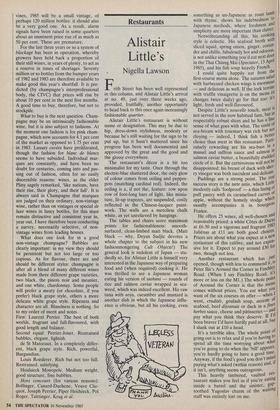Champagne
Degrees of effervescence
Ausonius
Ihave had my doubts about champagne. At times I have wondered whether the medium, the symbolism of luxury, the gold foil, the label, the idea of champagne was more important than the message in the bottle. Especially in the aftermath of wed- ding receptions, at six o'clock on a Satur- day evening, with a combined feeling of let-down and biliousness — does any other drink make one feel so ill?
Such doubts do not seem to be widely shared: we are in the midst of a champagne boom, with world demand going up by 18 per cent a year, and demand in the top ten export markets (among which Britain has just lost her historic position at the top of the league to America) rising even more rapidly, at an estimated 20-22 per cent. What could explain such a phenomenon? Will history look back on our time as another belle epoque, comparable to the years at the turn of the century, with Yuppies bringing bottles of Sainsburys Pink to dinner parties having taken over from Sarah Bernhardt bathing in bubbly? It seems improbable, since the spirit of our age, prudent and monetarist, is so differ- ent. All the same, our world wants effervescence, if only in a bottle: the current champagne boom is merely the tip of a sparkling iceberg, the hugely increas- ing worldwide demand for sparkling wines, and waters, of all kinds, from Perrier-Jouet to plain Perrier.
The only problem as far as champagne itself is concerned is that demand may soon outstrip supply, despite the extensive planting, or replanting, now taking place in the Marne valley. Yields in the Cham- pagne region, at the extreme northerly limit of viticulture, fluctuate widely: in 1981, for example, the production was 92 million bottles, and in 1982 295 million bottles. Because of the winter and spring frosts which killed off 2,000 hectares of vines, 1985 will be a small vintage, of perhaps 120 million bottles: it should also be a very good one. As a result, alarm signals have been raised in some quarters about an imminent price rise of as much as 50 per cent. These are premature.
For the last three years or so a system of blockage has been in operation, whereby growers have held back a proportion of their still wines, in years of plenty, to act as a reserve in times of shortages. Seventy million or so bottles from the bumper years of 1982 and 1983 are therefore available to make good this year's shortfall. It is pre- dicted (by champagne's interprofessional body, the CIVC) that prices will rise by about 10 per cent in the next five months. A good time to buy, therefore, but not to stockpile.
What to buy is the next question. Cham- pagne may be an intrinsically fashionable wine, but it is also subject to fashions. At the moment one fashion is for pink cham- pagne, which now accounts for 4.1 per cent of the market as opposed to 1.75 per cent in 1983. Luxury cuvees have proliferated, though the fashion for blanc de blancs seems to have subsided. Individual mar- ques are constantly, and have been no doubt for centuries, coming into and pas- sing out of fashion, often for no easily discernible reasons: wines, as the elder Pliny sagely remarked, 'like nations, have their rise, their glory, and their fall'. It is always said in Champagne that marques are judged on their ordinary, non-vintage wine, rather than on vintages or special de luxe wines in fancy bottles, for this must remain distinctive and consistent year in, year out. I have therefore been conducting a survey, necessarily selective, of non- vintage wines from leading houses.
What does one look for in a good non-vintage champagne? Bubbles are clearly important: in my view they should be persistent but not too large or too copious. As for flavour, there are and should be different styles: champagne is after all a blend of many different wines made from three different grape varieties, two black, the pinots noir and meunier, and one white, chardonnay. Some people will prefer a meaty (or chocolate, if you prefer) black grape style, others a more delicate white grape style. Ripeness and character are all. Blandness is nothing. So to my order of merit and notes.
First: Laurent Perrier. The best of both worlds, fragrant and full-flavoured, with good length and balance.
Second equal: Perrier-Jouet. Restrained bubbles, elegant, lightish.
de St Marceaux. In a completely differ- ent, black grape style. Rich, powerful, Burgundian.
Louis Roederer. Rich but not too full. Restrained, satisfying.
Heidsieck Monopole. Medium weight, good structure, fine bubbles.
Hors concours (for various reasons): Bollinger, Canard-Duchene, Veuve Clic- quot, Joseph Perrier, Piper Heidsieck, Pol Roger, Taittinger, Krug et al.



































































 Previous page
Previous page